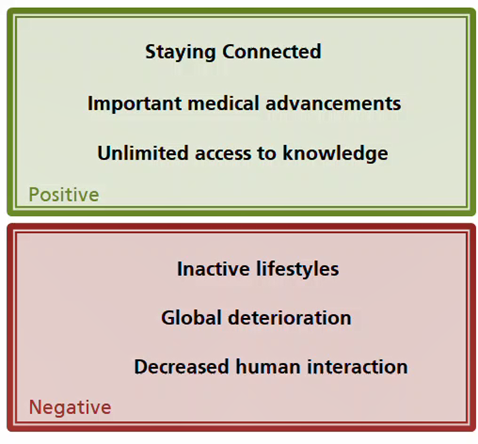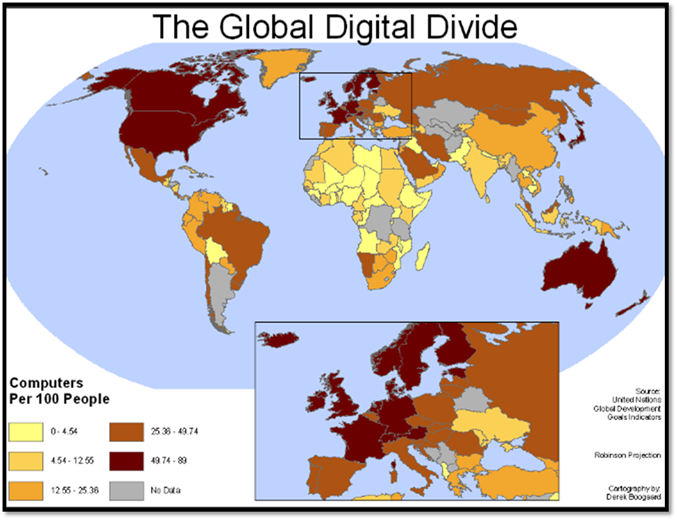Our
Digital World – Semester Exam

Objectives:
·
Acknowledge how access to technology has changed over the
decades
·
Identify how technology has impacted society
·
Recognize how technology has impacted the workplace
·
Define the digital divide
Advances in Digital Technology
Technology has become a large
part of everyday life for several people. For example, you there. You're taking
this course from a computer or maybe even a tablet. Can you believe only 20
years ago, taking a course like this would have been virtually impossible?
If you're taking this course, you are considered
a digital native. A person exposed
to technology from a young age is comfortable using it. However, technology
hasn't always been so readily available. Technology has transitioned from only
being available to the government, large companies, and wealthy individuals to
becoming a big part of most households. Here are a few technological
advancements that have significantly impacted everyday access to technology.
1990's
2000 – 2010
2011 +
Digital Technology in Society
Advancements in technology have had both
positive and negative effects on society. Let's take a look at a few of each.
Staying Connected: Technology allows
everyone with access the ability to stay connected. You can keep in touch with
family and friends from wherever you are. You can even see their faces with
technology like Facetime and Skype. In addition, you can stay connected to the
world around you. You no longer have to wait for the newspaper or the nightly
news on television. You can access around-the-clock coverage on the internet
and through social media. In some cases, social media has played a major role
in getting people to help when normal channels are unavailable.
Important Medical Advancements: Technological
advancements in medicine are not only improving health, but they are also
saving lives. From better ways to monitoring patients to 3D printing of life-saving
implants, some of today's medical advancements seem to be right out of science
fiction movies.
Unlimited Access to Knowledge: With the inventions
of technologies such as the internet, smart devices, apps, and WiFi, there is unlimited access to anything you want to
know right at your fingertips. "Google it," a popular phrase named
after the search engine, has become the standard language for finding
information. About anything you want to know can be found with an internet
search.
Inactive Lifestyles: What can't you do
from your computer or smart device? Very little except being active. With less
need to go places and do activities requiring movement, it seems harder and
harder to get up and get your body moving. With easy access to banks, retail
stores, and now even grocery outlets, people have less need to go outside. Your
body needs activity and the proper fuel to run efficiently.
Global Deterioration: The car and airplane
were great technological advancements that were amazing for humanity, but with
the pollution, they've caused, Earth needs some serious damage control. Technology
is being developed to help humans be less reliant on atmosphere-damaging fuels,
but it is still unavailable to the everyday consumer.
Decreased Human Interaction: People are becoming
socially awkward with less and less real human interaction. In other words,
digital natives have begun to rely on technology so much that they're having trouble
recognizing how their attitudes, behaviors, and actions affect the people they
interact with.

Digital Technology in the Workplace
Technology advancements have also had positive
and negative impacts on the workplace. We'll take a look at a few of each here.
Click each button to view more information.
Positive
Impact
Skilled
Labor Force: With repetitive tasks
being automated or taken over by machines, management can focus on hiring
employees with more education and enhanced skill sets. This provides a higher
quality of work for talented employees.
Impact
Connectivity: The internet and communication tools like Skype and Facetime
make connectivity easier. If permitted, employees can work from the office,
home, or even the local coffee shop. Not only can employees work from anywhere,
but they can also collaborate with other employees around the world. Though
there are challenges like time zones and possible language barriers, technology
can help promote global teamwork.
Efficiency: Technology can make
processes faster and more precise. This increases productivity and decreases
the time it takes to complete a task.
Negative
Impact
Dependency: Because employees have become so reliant on technology, there's
often a disruption in the workplace if technology fails or is unavailable. Loss
of power or interruption of internet service can cripple an office for hours or
even days.
No Downtime: Since work emails,
reports, and systems are so easily accessible, more and more employees are
taking work out of the office. They are taking less time for themselves to
relax, which can raise stress levels.
Changing
Technology: Technology changes at
a rapid speed, which causes software or systems purchased just two years ago to
be dinosaur-like. When technology becomes outdated, it can become inoperable or
incompatible with other technology, which makes it useless and costly to
replace.
The Global Digital Divide
Even though you see technology everywhere, and
though some people have unlimited access to it, some people have little to no
access. This is called the digital divide. A digital divide is an economic inequality
between groups broadly construed regarding access to, use, or knowledge of
information and communication technologies. The divide within a country may
refer to inequalities between individuals, households, and businesses.
For example, Amy's family may be able to afford
high-speed internet in their home, while Nancy's family cannot. The divide
between countries is referred to as the global digital divide. Many
individuals, households, and businesses have access to the latest and greatest
technology in the United States. However, in less developed countries, access
may be too expensive and unreachable for individuals, households, and businesses.
